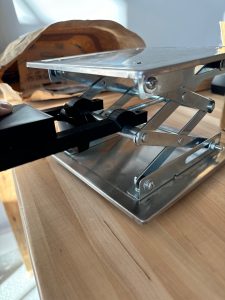The most significant risks to the project are: the new motor shield not supplying enough voltage to the motor. From here we can go in two directions: we can order a higher torque motor, or we can use a shield with a higher input voltage. If our motor is not torque-y enough, we will pursue both options because we have money to spend and we need a short execution latency because we only have 3 weeks left.
The main change to the block diagram was using a new motor shield with higher input voltage. If that shield is not enough, we will use a driver with an even higher input voltage, however, since this driver is not a shield that means will need two arduinos, one to control the actuators and the other to control the motor. This will be more difficult to integrate.
We are on schedule.
Week specific answers:
Tests we have run: stepping the motor with the driver, stepping the motor while it is mounted to the platform jack, running the motor continuously while mounted (these tests tested the structural integrity of the motor mount and the torque of the motor), and also height/angle adjustment without using actuation (i.e. we use our hands to manually change the height and the angle of the computer).
Future tests to run: torque of motor with new motor driver, running motor continuously with new motor driver, structural test of linear actuator mount. When system is fully integrated: time to complete height/angle adjustment (our goal is < 5 sec). Total weight of system (our goal is < 8 lbs). When running height adjustment, we will see if the top platform tilts, the is not good because it means the computer might fall over. We will ensure that the stand does not change height too quickly so people do not hurt themselves when sticking their fingers in between the jack arms.







